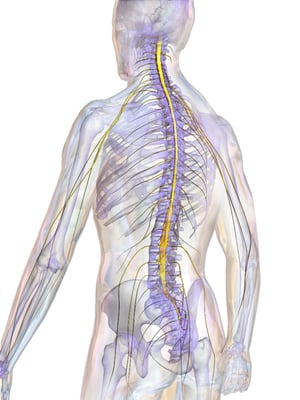
Medulloblastoma is one of the most common brain cancers in children and infants, and Group 3 medulloblastoma is the most aggressive subtype of that cancer. It accounts for fully 28% of all medulloblastomas and is associated with both fast spread and poor survival. When group 3 medulloblastoma metastasizes, it usually spreads to the spinal cord—which is enclosed inside the vertebrae (those bones in your back). Once group 3 medulloblastoma spreads, it becomes much more difficult to treat--as with many cancers. Scientists have had little success understanding this process in medulloblastoma, until very recently at Huntsman Cancer Institute.

HCI researcher Samuel Cheshier recently partnered with scientists from Stanford University School of Medicine to publish a study on that very process. Cheshier explains, “The need to understand medulloblastoma and how it spreads is incredibly important in order to know how to treat the cancer and find how to stop the disease from spreading, or metastasizing.”
In analyzing tumor samples from patients, the team found a protein called NOTCH1 that's deeply involved in metastasis of group 3 medulloblastoma. It moves around, embedded on the surface of cells like sprinkles, and finds its way to another protein called TWIST1, to which it attaches. That attachment causes a chain reaction, like dominoes falling, and metastasis (the spread of cancer) is the final domino in that chain reaction. In scientific terms, this sort of chain reaction is referred to as a signalling pathway.
They ran several experiments to confirm that the NOTCH1 signalling pathway initiates the spread of the brain cancer:
- In both human cells and mouse models, there is more NOTCH1 on the surface of medulloblastoma tumor cells taken from the spinal cord than on tumor cells taken from the brain. This suggests that growths in the spinal cord come from a group of tumor cells in the brain that had increased activity in the NOTCH1 signalling pathway.
- In samples from human medulloblastoma cancers, the team found that NOTCH1 is involved in cell movement.
- In actual human patients, more NOTCH1 is found in patients whose brain cancer has metastasized than in those whose cancer hasn't. Additionally, patients with higher levels of NOTCH1 lived, on average, for less time than those who had low levels of the protein on their tumor cells.
- When scientists transferred group 3 medulloblastoma cells into mice, tumor cells that had NOTCH1 on the surface metastasized to the spinal cord and tumor cells without NOTCH1 didn't spread. More mice with NOTCH1 tumors died. Essentially, cells with NOTCH1 were more invasive and better at spreading.
In the face of all this evidence, the team of scientists concluded that "the activation of the NOTCH1 signalling pathway increases group 3 medulloblastoma spinal metastasis" and that interfering with the pathway is a potential target for the creation of a new cancer treatment. Their work also suggests that interfering with the pathway doesn't seem to have adverse effects, making it an especially "promising target".
The researchers even tested a potential drug in mice with the cancer.
Their next step is developing a human clinical trial using the drug they tested in mice. It would likely be administered directly to the fluid surrounding the brain and spinal cord near where a patient's tumors are located. The team hopes it will have few side effects and lead to more effective treatment of the common childhood brain cancer.
Sources:
Blausen 0822 SpinalCord[Photograph]. (n.d.). Wikimedia Commons. Retrieved October 29, 2018, from https://commons.wikimedia.org/wiki/File:Blausen_0822_SpinalCord.png. (Originally photographed 2013, August 20)
Desouza, R., Jones, B. R., Lowis, S. P., & Kurian, K. M. (2014). Pediatric Medulloblastoma — Update on Molecular Classification Driving Targeted Therapies. Frontiers in Oncology,4. doi:10.3389/fonc.2014.00176
Kahn, S. A., Wang, X., Nitta, R. T., Gholamin, S., Theruvath, J., Hutter, G., . . . Cheshier, S. H. (2018). Notch1 regulates the initiation of metastasis and self-renewal of Group 3 medulloblastoma. Nature Communications,9(1). doi:10.1038/s41467-018-06564-9
Spinal Cord - National Library of Medicine - PubMed Health. (n.d.). Retrieved from https://www.ncbi.nlm.nih.gov/pubmedhealth/PMHT0024392/
Study Holds Promise for New Pediatric Brain Tumor Treatment. (2018, October 11). Retrieved from https://huntsmancancer.org/newsroom/2018/10/new-pediatric-brain-tumor-treatment.php
The Armed Forces Institute of Pathology. (n.d.). AFIP405851R-MEDULLOBLASTOMA[Photograph]. Wikimedia Commons. Retrieved April 11, 2009, from https://commons.wikimedia.org/wiki/File:AFIP405851R-MEDULLOBLASTOMA.jpg.

 0 Comments
0 Comments
